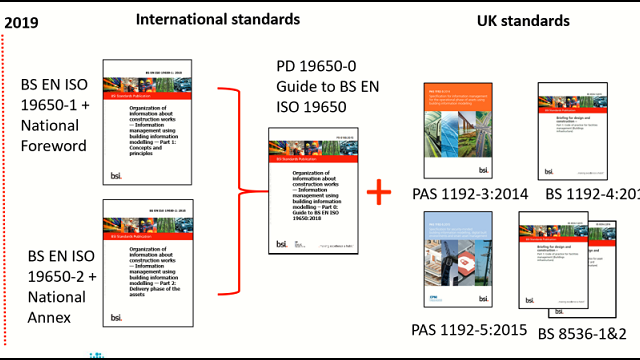The International Organisation for Standardisation (ISO) have published the first two international standards for Building Information Modelling (BIM) noted below with their UK references codes:
BS EN ISO 19650–1 Organisation of information about construction works – Information management using building information modelling – Part 1: concepts and principles and
BS EN ISO 19650-2 Organisation of information about construction works – Information management using building information modelling – Part 2: Delivery phase of assets.
These two ISO 19650 standards supersede BS1192:2007 + A2:2016 (principles) and PAS1192 part 2 (capital/delivery phase).
The principles of both BS EN ISO 19650-1 and 2 are founded on the UK’s standards for information management using BIM and will be identifiable to those that are already using BS1192 and PAS1192-2. BS EN ISO 19650 is fundamentally an internationalisation of the UK’s BIM L2 model and contains all the same principles and high-level requirements with specific UK content contained in our National Annex.
ISO19650 refers to “stages of maturity of analogue and digital information management” with the current ISO supporting a container based collaborative working approach. In the UK we will still reference BIM Level 2 as our equivalent.
Why are we moving to international BIM standards?
The UK’s decision to trigger the move from BIM Level 2 as a UK Standard to international standards is rooted back to 2011 and the ‘Report for the Government Construction Client Group – BIM Strategy Paper.’ The report encouraged the greater adoption of BIM within the UK domestic construction sector and at the same time recognised that BIM would become a disruptive and ‘game changing’ way of working which would have a profound effect on global construction, further, that BIM technologies and processes transcended national or geographic borders. Therefore, during the development of the UK BIM Programme there was growing consensus that BIM-globalisation would inevitably push towards international norms and standards.
Accordingly, the UK, working through its national standard body [BSI], industry and academic organisations and networks, used its existing suite of standards which, by that time, had demonstrated its effectiveness as a tool to aid systematic adoption, as a foundation for collaboration with other nations to develop international standards. The premise of this collaborative approach was that benefits would be realised by all nations, including a common security-minded approach to the adoption of these powerful data/information rich models and tools. Collaterally it was anticipated that such a response would also lay the foundations for a level playing field for international markets and foster trade.
UK Specific documentation to support the transition
To support of the implementation of these two new international standards the British Standards Institution (BSI) has also published a National Annex to BS EN ISO 19650-2 [to aid execution in the UK and ensure BIM Level 2 can be delivered within the context of the ISO framework], National Foreword and a UK Transition Guidance.
The National Annex and Foreword are informative texts that provide contextual and supplementary information that does not conflict with the base ISO document.
The National Foreword contains clarification of clauses within ISO 19650 in relation to other documents in the UK BIM Level 2 suite.
The National Annex clarifies any regional, language or country specific usage i.e. equivalent UK terms as opposed to those used in ISO 19650. For example, ISO19650 uses the term “exchange information requirements” where the UK equivalent is “employer’s information requirements.” The Annex also covers the UK interpretation for Container naming conventions, Field codification, Container attributes, Container states and Project Archive.
The UK Transition Guidance is a technical published document produced to help all those who have been using BS 1192:2007+A2:2016 and PAS 1192-2:2013, as part of their implementation of BIM Level 2, to transition to the new ISO standards BS EN ISO 19650-1 and BS EN ISO 19650-2. The transition guidance is not aimed at those who are brand new to this standard of information management but those already working in a BIM Level 2 environment. A link can be found here upon publication.
What about the other standards in the BIM Level 2 suite?
At present all other standards in the BIM Level 2 suite will remain extant and part of the new BIM Level 2 suite:
PAS 1192-5:2015 Specification for security-minded building information modelling, digital built environments and smart asset management.
PAS 1192-3:2014 Specification for information management for the operational phase of assets using building information modelling (BIM)
BS 1192-4:2014 Collaborative production of information. Fulfilling employer’s information exchange requirements using COBie.
BS 8536-1:2015 Briefing for design and construction. Code of practice for facilities management (Buildings infrastructure)
BS 8536-2:2016 Briefing for design and construction. Code of practice for asset management (Linear and geographical infrastructure)
The diagram below conceptualizes the UK BIM Level 2 standards in the context of ISO 19650:

ISO 19650 – 1 and 2 are the first in the move towards international standards and both PAS1192-3 and PAS1192-5 are in the process of transitioning to ISO [planned for 2020 publication] and will become:
BS EN ISO 19650-3 Organization of information about construction works Information management using building information modelling – Part 3: Operational phase of assets
BS EN ISO 19650-5 Organization of information about construction works – Information management using building information modelling – Part 5: Security-minded approach to information management.
There are no plans at the moment for BS1192-4 to become an ISO.
So, what are the main changes?
Even though ISO 19650 is built upon the UK’s standards BS1192:2007+A2:2016 and PAS 1192-2:2013 there were necessary changes in terminology and language to turn UK documents into international documents however as noted previously the UK Annex helps translate these backs to the existing terminology baseline.
Beyond terminology and language, the key transitional highlights are summarised below:
-
Lifecycle information principles
The presentation of a holistic set of information management concepts and principles in BS EN ISO 19650-1, to cover both project delivery and asset operation parts of an asset lifecycle. These concepts and principles are supported by detailed requirements for project delivery in BS EN ISO 19650-2, which itself includes further recommendations in the UK National Annex.The ISO notes that the concepts and principles contained within the standard should be applied in a way that is proportionate and appropriate to the scale and complexity of the asset or project. This fits well with the SFT BIM Grading tool approach to ensure that the level of BIM deployment on a project is appropriate. -
Information Management Process – Delivery Phase
The ISOs follow a very clear step by step approach to articulating the information management process, workflows and procedures from “Appointing project information management roles” through to “Project close out [end of delivery phase]”.
-
BIM Maturity
The ISO refers to stages of maturity of analogue and digital information management with ISO 19650 referencing a container‐based collaborative working approach. In the UK we will meantime position the adoption of the ISO 19650 plus other relevant BIM standards as per the UK Annex as a BIM Level 2 maturity. -
Responsibility Matrix
The ISO provides improved clarification around the concept of the responsibility matrix with two types: one to assign information management activities, the other to allocate responsibility for the delivery teams information delivery. The information delivery matrix is a core set of information deliverables, in relation to each element of the information model with assigned responsibility to produce each deliverable to a specific task team. Together these matrices support a much clearer information delivery planning process. -
Level of Information Need
The broad concept of the level of information need with a focus on information models structured repositories of all information needed for making decisions during the whole life cycle of a built environment asset. This can be defined in terms of any metrics that are appropriate to the project, including level of information and level of detail that is familiar within the UK. -
The Common Data Environment
The ISO refers to CDE states instead of CDE areas, and to information container suitability instead of status. There is a more developed concept around the archiving of information with an Archive state which is used to hold a complete record of all superseded containers that have been shared and published during the information management process. A container in the archived state that was previously in the published state is a record of contractual information at that time. -
Risk
The ISO has more explicit requirements to consider risks associated with the timely delivery of information and the need to undertake an assessment of the risks. There is also a need for the delivery team to develop a risk register to support the management of any potential identified risks. -
Volume Strategy
Instead of volume strategy the connected concepts of a federation strategy and a container breakdown strategy are introduced. -
Naming Conventions
The identification of information containers (naming convention) in the UK National Annex to BS EN ISO 19650-2 has been adjusted in response to industry feedback since the publication of BS 1192 and PAS 1192-2. -
Lead Appointed Parties
The documents to be developed by lead appointed parties and appointed parties (suppliers) are broken down into more detail in BS EN ISO 19650-2. This is to support clearer scalability to different types of project and appointment. These include a delivery team’s mobilisation plan and as previously noted risk register. -
Referencing of parties
The ISO changes how parties are referenced (i.e. from “employer” and “supplier” to “appointing party” and “appointed party”). This allows for a more flexible implementation across both project delivery and asset operation scenarios.





